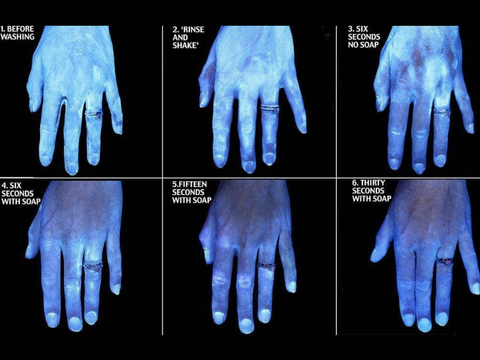Does handwashing really reduce the spread of germs?
Is hand washing actually effective at reducing the spread of germs? We all hear the advice to wash our hands before we eat. During flu season there are extra reminders to wash our hands. But is it really effective in preventing illness?
The short answer is yes but it matters how you wash your hands and for how long. Let’s look at some of the research to understand why washing our hands is effective and the steps we need to follow to reduce the spread of germs.
A few years ago we wrote a blog post about using cold water for washing hands. It’s a common myth that you have to use warm water and we addressed why you don’t need warm water to wash your hands.
A graphic of germs on hands washed in various ways became viral on Facebook and around the internet. It is from a simple hand washing experiment.

The test was done in 2015 by Jennie Agg, a reporter at the Daily Mail. She conducted an experiment using “Glo Germ” which shows germs under a UV camera. The images show how many germs were washed off by various methods and lengths of hand washing. You can see in this graphic, that using soap and friction for 20-30 seconds was the most effective at reducing the amount of germs on her hands.
The common “rinse and shake” method many use in their daily bathroom routine, does not actually do much to reduce the presence of germs. Many illnesses can be transmitted by viruses and bacteria that we pick up on our hands. Washing our hands effectively after going to the bathroom, is key in reducing our risk of illness and not spreading it to others. Other key times we need to practice proper hand washing techniques include: before and after preparing food, before eating, after changing diapers, after wiping noses and after touching common public surfaces.
“Fecal bacteria on hands is really common, explains Dr Val Curtis, an expert in hygiene and public health at the London School of Hygiene & Tropical Medicine. ‘We did a study of commuters around England and found that 28 percent had it on their hands.’ ” (Daily Mail article).
This statistic may sound gross, but we need to be reminded of how common illnesses spread. Our typical “wash and shake” hand washing method fails in actually cleaning our hands.
Friction and Soap for Effective Hand washing
Water and soap alone do not kill or remove germs from our hands. The action of rubbing our hands together with soap is the most effective in reducing the spread of germs. Soap aids in this process by sticking to the germs attached to the natural oils on our skin and allowing them to be rinsed off along with the soap. When we rub our hands and fingers together and rub our fingers on our nail beds, we allow the soap to come in contact with the microbes, or germs, on our hands. The more that stick to the soap and get rinsed off, the cleaner our hands will be. You can learn more about why soap is effective in this article by Live Science.
This study on the efficacy of hand washing to reduce bacteria showed that washing hands with soap and water reduced the presence of bacteria to just 8%. It’s another example that hand washing really does help reduce the spread of germs when the proper techniques are used.
Time Matters
Most health organizations, including the CDC and the World Health Organization, recommend washing your hands for 20-30 seconds. There are some that maintain 10-15 seconds is also effective. Washing the front and back of your hands, fingers and nails for 20 seconds with soap will significantly reduce the amount of germs on your hands. When done consistently after using the bathroom and before eating, we can reduce the risk of getting sick and spreading germs.
Even if you have read and heard this information before, it’s always a good to remind ourselves why hand washing is effective. In our fast paced culture, why does 20 seconds seem so long to us that we have to rush out of the bathroom after a 3 second rinse? If you think about the time you will gain from not getting sick as often, washing your hands for 20 seconds is a good time investment.
Portable sinks help increase access to hand washing stations. Schools, businesses and community spaces have used portable sinks in high traffic areas. We provide sinks that operate without traditional plumbing so you can choose the best places to provide more hand washing sinks. Reducing the spread of germs is not only about having a sink, but having the right number of sinks so students, crowds and customers can have adequate time washing their hands using proper techniques.